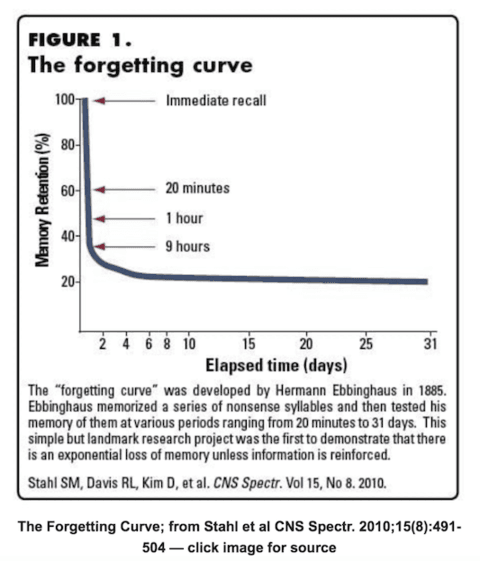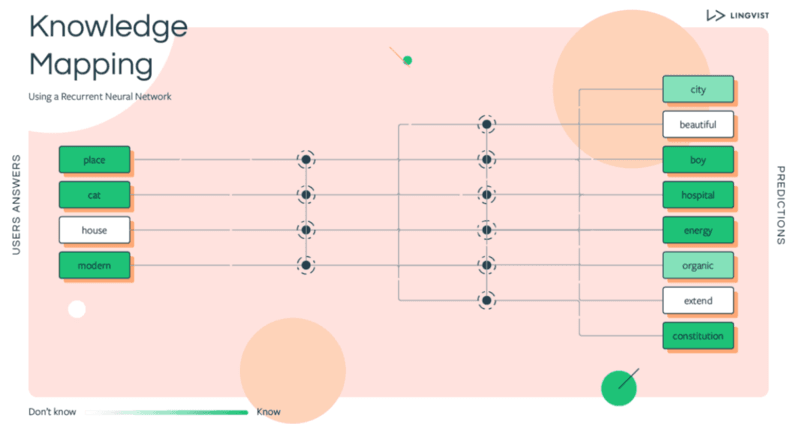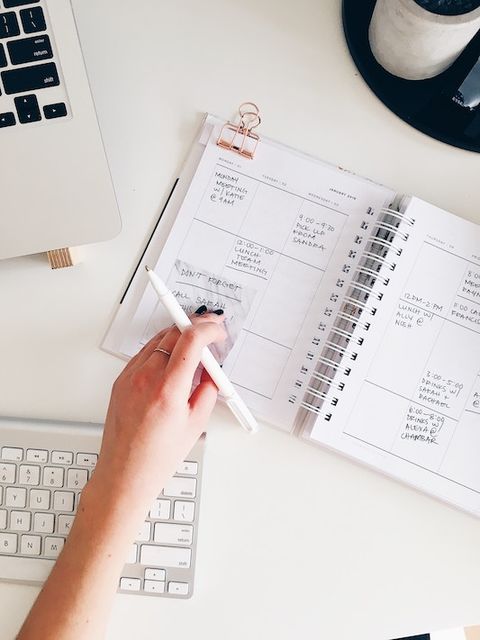
Language learning researchers estimate that someone who knows between 800–1,000 words can successfully participate in basic, everyday conversations. After learning 2,000 words, research suggests you can understand about 80% of a text. Considering that you probably want to have some time left over to actually use your second language (before you’re in retirement), how can you learn one to two thousand words in a reasonable time frame? The key is forgetting to remember, or using your brain’s natural cyclical processes for moving new information into long-term storage to your advantage.
It sounds odd, but in order to cement something in your memory, you have to allow yourself to start to forget it. It turns out that there is actually a very specific window of time in which it’s best to review information that you’ve just begun to forget. But how are you supposed to know whether or not you’ve forgotten something? How can you pin down this optimal time frame? Luckily, researchers have developed a mathematical model that can track and predict this curve. Even better, with technology, we are finally able to put these findings into practice.
What Is Spaced Repetition?
Experimental psychologists have been trying to pin down the exact behavior of items in our memory for over a century. In the late nineteenth and early twentieth century, Hermann Ebbinghaus discovered several patterns with regard to how quickly people are able to memorize information. He also tracked when that information starts to “decay” or become more difficult to call up. He described these patterns and findings as the learning curve, the forgetting curve, and the spacing effect. These patterns are foundational to the concept of spaced repetition (a.k.a. repetition scheduling and repetition learning), which is the usage of gradually increasing intervals to create an optimal learning schedule.


Learn a new language with Lingvist
Learn the words you actually need, when you need them
Early Applications
Several memory researchers have attempted to apply the concept of spaced repetition in a practical system. In the 1970s, Sebastian Leitner designed a flashcard system in which incorrectly answered cards were shuffled back into the deck to allow someone to review items that they had missed. Unfortunately, the application was too complex for the average person to implement in real life, as it required a lot of effort to correctly organize the cards, as well as keep track of the increasing intervals for cards which had a higher frequency of being incorrectly guessed. Around the same time, Paul Pimsleur was the first to apply these discoveries to language learning via audio tapes. Though his program was an improvement on rote textbook memorization of foreign language vocabulary, it lacked the personalization of Leitner’s flashcard system.
Spaced Repetition Today

Fast forward to present day, and spaced repetition software and computer programs remove the need for static learning techniques such as flashcards or audiotapes. Learners are now able to directly interact with the learning “recipe” without even being aware that they are doing so. Algorithms that power online language learning platforms are aided by artificial intelligence and machine learning, allowing them to be responsive to the needs of the learner and analyze massive data sets for significant statistical patterns. Both the systematically increasing time intervals of spaced repetition and the personalization of the flashcard system can be realistically achieved.
Spaced repetition is at the heart of Lingvist’s language courses, which adapt their curricular content in real time, meaning that the lessons proceed at your pace. Though language teachers are fantastic for conversation practice and coaching, the reality is that in a traditional 30-person classroom they are not able to adapt the lessons to everyone’s needs. The result is that some lessons move too quickly or include too much information for some and move too slowly for others. This is especially true if you’re learning a language in a class of mixed native language speakers, whose languages may or may not overlap in similarities in grammatical structures or related words (cognates). When you’re using a Lingvist course you tend to score better on words or with features that are similar between your language and the language you want to learn, so the spaced repetition algorithm allows you to focus on what’s different.
Knowledge Mapping

Lingvist’s Knowledge Mapping Engine (KME) starts working when you first begin using the application. During your placement test, it adapts to your current level of knowledge and predicts which words you do or don’t know. The placement test notes your ability to translate up to 50 words of varying difficulty, after which it uses a model to predict your ability to correctly translate over 2,000 more words in the course. Using this forecast, it switches off words that you already know and switches on words you probably haven’t learned, based on the collective history of other Lingvist users that scored similarly on the test. In studying the actual results of learners, data analysts have determined that the KME is up to 90% accurate in its predictions of which words you will be able to translate correctly. Once you begin using the app regularly, the spaced repetition system continually tweaks and updates your lesson plan accordingly.
Lingvist’s Spaced Repetition System
The designers of Lingvist took memory researchers’ findings into account when creating their spaced repetition algorithm, which improves recall by carefully controlling the number of repetitions of a given word. The algorithm starts with the average forgetting curve of all of Lingvist’s users as a baseline, and then adjusts according to how many you miss. That means that every single answer you submit becomes an input for your personal model.
Lingvist uses a model based on a custom implementation of a modeling system (called ACT-R) introduced by Anderson & Lebiere in 1998. This system predicts the “percentage” of a word that a learner remembers at a given time, or in other words, how close it is to being completely forgotten (0%) or immediately available (100%) when prompted for use.
This unique system is called Lingvist’s memory curve model, as it is able to combine information about the forgetting curve of an individual learner and the forgetting curve for an individual word previously learned. This translates into a personalized experience for each user for each word.
By studying current research in the field and analyzing the data of all of Lingvist’s current users, the Lingvist team has determined that the ideal time to schedule a repetition is when the learner remembers a word at the 80% level. Exercises are then tailored to this ideal interval in between being exposed to a word and the probability (based on past performance) that you’ll get the word right.
What’s the Catch?

The customized spaced repetition algorithm is based on a regular interaction schedule, meaning daily (ideal!) or regular usage is crucial. According to Lingvist data scientist Mikk Tõnissoo, the team has discovered that there is a range of usage that optimizes the spaced repetition technology, allowing learners to hit the sweet spot of the forgetting curve. The recommended regimen is to learn at least 50 cards in four to seven days, but ideally following the daily 100-20-1 rule: 100 cards, 20 new words, 1 challenge.
Lingvist, with its tailored exercises and Custom Decks, is the fastest tool for acquiring vocabulary on the market. However, without regular practice, the words that need review will stack up and the effectiveness of the system decreases. In this case, the most challenging part of becoming fluent in a new language is not the actual learning process, but the forming of a new habit. Due to the design of Lingvist’s memory curve model, people who use the app regularly can recall about 80% of all of the words they’ve seen so far.
So how quickly can someone reach a goal of 2,000 words? According to the usage data that Lingvist’s data team has analyzed to this point, it takes an average of 17 hours for someone to learn 2,000 words. Of course, some people prefer to practice in many small bursts, while others prefer longer sessions. The most important part is setting a realistic schedule for yourself and establishing that new habit. Luckily, Lingvist allows you to learn whenever and wherever you’d like, and the algorithm will always be working tirelessly to support your learning journey!




